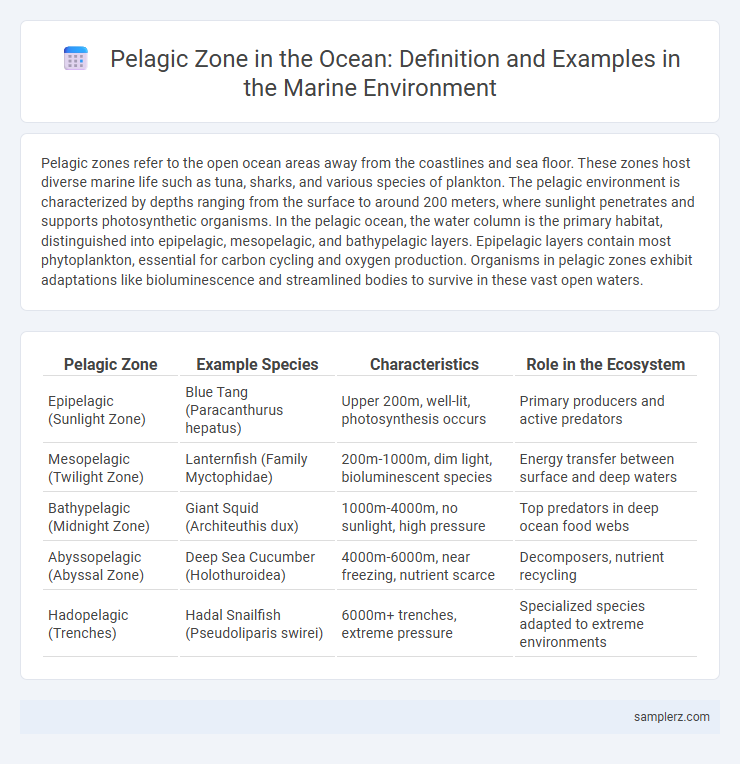Pelagic zones refer to the open ocean areas away from the coastlines and sea floor. These zones host diverse marine life such as tuna, sharks, and various species of plankton. The pelagic environment is characterized by depths ranging from the surface to around 200 meters, where sunlight penetrates and supports photosynthetic organisms. In the pelagic ocean, the water column is the primary habitat, distinguished into epipelagic, mesopelagic, and bathypelagic layers. Epipelagic layers contain most phytoplankton, essential for carbon cycling and oxygen production. Organisms in pelagic zones exhibit adaptations like bioluminescence and streamlined bodies to survive in these vast open waters.
Table of Comparison
| Pelagic Zone | Example Species | Characteristics | Role in the Ecosystem |
|---|---|---|---|
| Epipelagic (Sunlight Zone) | Blue Tang (Paracanthurus hepatus) | Upper 200m, well-lit, photosynthesis occurs | Primary producers and active predators |
| Mesopelagic (Twilight Zone) | Lanternfish (Family Myctophidae) | 200m-1000m, dim light, bioluminescent species | Energy transfer between surface and deep waters |
| Bathypelagic (Midnight Zone) | Giant Squid (Architeuthis dux) | 1000m-4000m, no sunlight, high pressure | Top predators in deep ocean food webs |
| Abyssopelagic (Abyssal Zone) | Deep Sea Cucumber (Holothuroidea) | 4000m-6000m, near freezing, nutrient scarce | Decomposers, nutrient recycling |
| Hadopelagic (Trenches) | Hadal Snailfish (Pseudoliparis swirei) | 6000m+ trenches, extreme pressure | Specialized species adapted to extreme environments |
Defining Pelagic Zones in the Ocean
Pelagic zones in the ocean encompass the open water column away from the shore and seabed, divided into distinct layers such as the epipelagic, mesopelagic, bathypelagic, abyssopelagic, and hadalpelagic zones. Each zone varies in depth, light availability, temperature, and pressure, shaping diverse ecosystems from sunlit surface waters inhabited by plankton and fish to the dark, high-pressure environments where bioluminescent species thrive. Key examples of pelagic organisms include copepods in the epipelagic zone and giant squid in the bathypelagic, illustrating adaptations to their specific habitats within the vast oceanic pelagic environment.
Importance of Pelagic Ecosystems
Pelagic ecosystems in the open ocean support a vast array of marine life, including key species such as tuna, sharks, and plankton, which form the foundation of marine food webs. These ecosystems play a critical role in carbon cycling by facilitating the sequestration of atmospheric CO2 through biological processes in phytoplankton. Protecting pelagic zones ensures biodiversity conservation and the sustainability of global fisheries that millions depend on for food and livelihood.
Key Characteristics of Pelagic Habitats
Pelagic habitats in the ocean are characterized by open water environments away from the coast and seafloor, encompassing the epipelagic, mesopelagic, and bathypelagic zones. These habitats support diverse marine life adapted to varying light levels, pressure, and nutrient availability, such as phytoplankton in the epipelagic zone and bioluminescent organisms in deeper layers. Key features include vast spatial distribution, dynamic water currents, and stratified temperature gradients that influence biological productivity and species distribution.
Common Pelagic Species in Oceans
Common pelagic species in oceans include tuna, mackerel, and herring, which inhabit the open water column away from the sea floor. These species play a crucial role in marine food webs by supporting predators such as sharks, dolphins, and seabirds. Their populations are indicators of ocean health and are often affected by factors like overfishing and climate change.
Adaptations of Pelagic Organisms
Pelagic organisms in the open ocean exhibit adaptations such as streamlined bodies for efficient swimming and buoyancy control through gas-filled swim bladders or lipid storage. Many have developed bioluminescence for camouflage and communication in the deep sea's low-light conditions. Their sensory organs are highly specialized to detect vibrations and chemical signals in vast, nutrient-scarce environments.
Food Chains in Pelagic Environments
Pelagic food chains in oceanic environments begin with phytoplankton, microscopic plants that perform photosynthesis and form the base of the marine food web. Zooplankton consume phytoplankton, serving as a crucial energy transfer to larger species such as small fish, squid, and eventually apex predators like sharks and tuna. This dynamic sustains biodiversity and nutrient cycling within the open water column, highlighting the importance of pelagic zones in global marine ecosystems.
Human Impact on Pelagic Zones
Human activities such as overfishing, plastic pollution, and chemical runoff significantly disrupt pelagic zones in the ocean, threatening biodiversity and altering food webs. Microplastics accumulate in pelagic organisms, causing harm to marine species and introducing toxins to higher trophic levels. Climate change-induced ocean warming also exacerbates habitat loss, reducing the resilience of pelagic ecosystems worldwide.
Conservation Efforts for Pelagic Biodiversity
Pelagic zones in the ocean, home to species like tuna, whales, and jellyfish, benefit from marine protected areas (MPAs) designed to conserve pelagic biodiversity by limiting fishing and habitat disruption. International agreements, such as the Convention on Migratory Species, promote sustainable practices to prevent overfishing and protect migratory routes vital for pelagic organisms. Technological advancements in tracking and monitoring enable more effective enforcement of conservation measures, ensuring the health and resilience of these open-ocean ecosystems.
Threats Facing Pelagic Ecosystems
Pelagic ecosystems in the open ocean face significant threats from overfishing, which depletes key species like tuna and swordfish, disrupting food webs. Pollution, including plastic debris and chemical contaminants, accumulates in these waters, harming marine life such as plankton and pelagic fish. Climate change causes ocean warming and acidification, leading to habitat shifts and decreased biodiversity in pelagic zones.
Future of Pelagic Life in a Changing Climate
Pelagic life in the ocean, including species like tunas, sharks, and jellyfish, faces significant challenges due to rising sea temperatures and acidification caused by climate change. Shifts in plankton populations, which form the base of the pelagic food web, significantly affect the survival and distribution of these open-ocean organisms. Ongoing research emphasizes the importance of monitoring pelagic ecosystems to predict changes and implement sustainable conservation strategies that protect biodiversity and fisheries livelihoods.

example of pelagic in ocean Infographic
 samplerz.com
samplerz.com